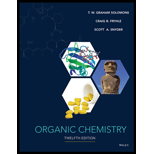
Concept explainers
Draw a three-dimensional orbital representation for each of the following molecules, indicate whether each bond in it is a σs or πp bond, and provide the hybridization for each non-hydrogen atom.
(a)
Want to see the full answer?
Check out a sample textbook solution
Chapter 1 Solutions
ORGANIC CHEM. VOL.1+2-W/WILEYPLUS
Additional Science Textbook Solutions
Chemistry For Changing Times (14th Edition)
Chemistry & Chemical Reactivity
Chemistry & Chemical Reactivity
Chemistry: An Introduction to General, Organic, and Biological Chemistry (13th Edition)
General, Organic, and Biological Chemistry (3rd Edition)
Living By Chemistry: First Edition Textbook
- Aspirin, or acetylsalicylic acid, has the formula C9H8O4 and the skeleton structure (a) Complete the Lewis structure and give the number of bonds and bonds in aspirin. (b) What is the hybridization about the CO2H carbon atom (colored blue)? (c) What is the hybridization about the carbon atom in the benzene-like ring that is bonded to an oxygen atom (colored red)? Also, what is the hybridization of the oxygen atom bonded to this carbon atom?arrow_forwardIdentify the orbitals on each of the atoms that form the bonds in H3CCN. How many bonds and bonds form?arrow_forwardThe drawing below shows the overlap of two hybrid orbitalsto form a bond in a hydrocarbon. (a) Which of the followingtypes of bonds is being formed: (i) C¬C σ, (ii) C¬C π,or (iii) C¬H σ? (b) Which of the following could be theidentity of the hydrocarbon: (i) CH4, (ii) C2H6, (iii) C2H4, or(iv) C2H2?arrow_forward
- Convert the following molecular formulas into linebond structures: (a) C3Ha (b) C3H;Br (two possibilities) (c) C3H6 (two possibilities) (d) C2H.O (two possibilities) Identify the bonds in the following molecules as covalent, polar covalent, or ionic (a) BeF2 What is the hybridization of each carbon atom in acetonitrile, CH3C=N? (b) SİH4 (с) СВraarrow_forwardIn ozone, O3, the two oxygen atoms on the ends of the molecule are equivalent to one another. (a)What is the best choice of hybridization scheme for the atoms of ozone? (b) For one of the resonance forms of ozone, which of the orbitals are used to make bonds and which are used to hold nonbonding pairs of electrons? (c) Which of the orbitals can be used to delocalize the π electrons? (d) How many electrons are delocalized in the π system of ozone?arrow_forwardH genistein HO, H H : ОН HO, H (a) Is the hybridization of each C in the right-most ring the same? Explain. (b) Is the hybridization of the O atoms in/on the center ring the same as that of the O atoms in the OH groups? Explain. (c) How many carbon-oxygen o-bonds are there in genistein? How many carbon-oxygen n-bonds? (d) Do all the lone pairs on the oxygens occupy the same type of hybrid orbital? Explain by labeling the hybridization of each oxygen atom in genistein.arrow_forward
- (a) State the hybrid orbitals for C1,C2,O1 and O2 (b) state the number of π bonds present (c) State teh number of C atoms with sp2 hybridization.arrow_forwardOctocrylene is an ingredient found in topical sunscreens. It is a water-resistant molecule that helps protect skin against harmful UVA and UVB radiation. (a) What is the hybridization of each nonhydrogen atom? (b) Circle all atoms bonded to the acyclic C=C double bond that are required to be in the same plane. (c) Are there two unique configurations possible about the acyclic C=C double bond? Explain. (d) Which of the two C-C single bonds indicated by arrows would you expect to be shorter? Explain. Octocrylenearrow_forwardLactic acid is a natural compound found in sour milk. (a) How many π bond occur in lactic acid? How many u bonds? (b) What is the hybridization of atoms 1, 2, and 3? (c) Which CO bond is the shortest in the molecule ? Which CO bond is the strongest? (d) What are the approximate value of the bond angles A, B and C?arrow_forward
 Chemistry: Principles and PracticeChemistryISBN:9780534420123Author:Daniel L. Reger, Scott R. Goode, David W. Ball, Edward MercerPublisher:Cengage Learning
Chemistry: Principles and PracticeChemistryISBN:9780534420123Author:Daniel L. Reger, Scott R. Goode, David W. Ball, Edward MercerPublisher:Cengage Learning Chemistry: Principles and ReactionsChemistryISBN:9781305079373Author:William L. Masterton, Cecile N. HurleyPublisher:Cengage Learning
Chemistry: Principles and ReactionsChemistryISBN:9781305079373Author:William L. Masterton, Cecile N. HurleyPublisher:Cengage Learning Chemistry: The Molecular ScienceChemistryISBN:9781285199047Author:John W. Moore, Conrad L. StanitskiPublisher:Cengage Learning
Chemistry: The Molecular ScienceChemistryISBN:9781285199047Author:John W. Moore, Conrad L. StanitskiPublisher:Cengage Learning Chemistry & Chemical ReactivityChemistryISBN:9781133949640Author:John C. Kotz, Paul M. Treichel, John Townsend, David TreichelPublisher:Cengage Learning
Chemistry & Chemical ReactivityChemistryISBN:9781133949640Author:John C. Kotz, Paul M. Treichel, John Townsend, David TreichelPublisher:Cengage Learning Chemistry & Chemical ReactivityChemistryISBN:9781337399074Author:John C. Kotz, Paul M. Treichel, John Townsend, David TreichelPublisher:Cengage Learning
Chemistry & Chemical ReactivityChemistryISBN:9781337399074Author:John C. Kotz, Paul M. Treichel, John Townsend, David TreichelPublisher:Cengage Learning




